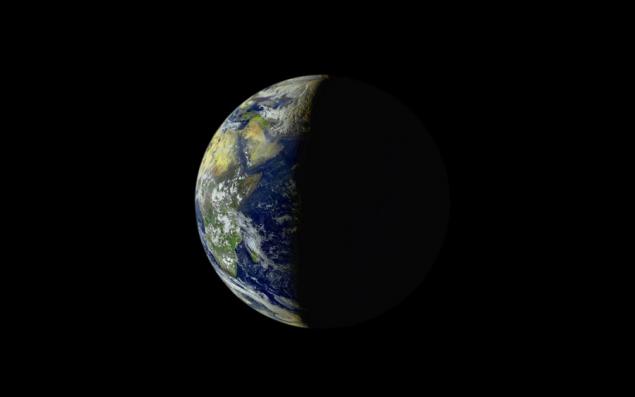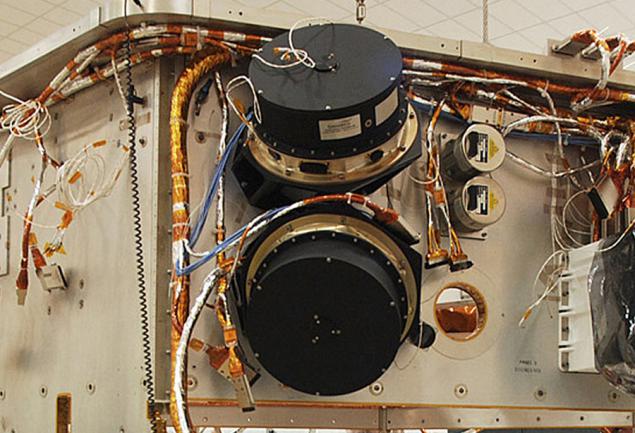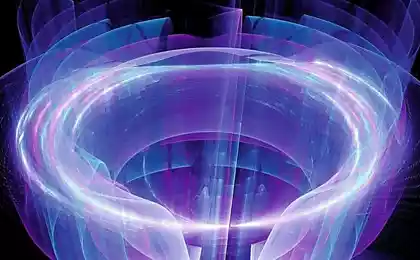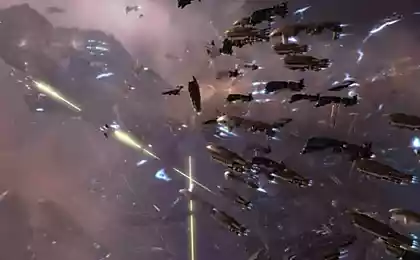1479
The battle for the "Electro-L"
In a spacecraft "Electro-L" had problems with orientation and stabilization system. Technicians NPO. Lavochkin doing everything possible to accurately diagnose the problem and, if possible, eliminate it.

The last, at this point, the frame from the satellite. i> ( On the desktop a >)
A little more than three years "Electro-L" is rotated in a geostationary orbit at an altitude of 36 thousand. Km. And more than two consecutive years, every 30 minutes he created a magnificent 120-megapixel images of the visible disk of the Earth. The first shot he made in February 2011 and has since worked in the interests of Roshydromet and the Russian Federal Space Agency. At the same time, delighting us with the opportunity to watch the home planet almost online.
"Patience is the limit of the car ...» © 2 April, I, as the creator of the group & quot; satellite "Electro-L » Vkontakte wrote: & quot ; What happened? Already six o'clock pictures are not updated? I> & quot; At first I ignored the question. With the machine occasionally held any maintenance work or disable the reception of images, if the sun is shining into the lens. But after an hour at the Forum "News of Cosmonautics» написали: & quot; Paused publishing pictures ... Everything was in order with the satellite? i> & quot ;. A little later it was reported that there was a problem with KUDM (control complex motor-flywheel).
It has meant a serious problem. A similar situation six months ago, there was a space telescope NASA Kepler - hunter for exoplanets. He denied two of the four reaction weels, because of which he almost ceased activity, and, as is typical, too, after three years of successful work. At that time, NASA is actively informed about this situation, therefore, probably many have heard of it.

The vernal equinox in 2014 with the Electro-L i> ( On the desktop ) < br />
The principle of "Electro-L" is largely similar to Kepler, although our unit removes not the stars, and the earth, but the goal of stabilizing and orientation he is almost similar - look in one point and occasionally to take pictures. For the "sighting" spacecraft system used motor flywheel or gyrodynes (gyrodynes can still change the axis of rotation, but the "Electro-L" are rigidly fixed). Sometimes mistakenly called gyroscopes, for a similar principle. In fact, both - a pinwheel. Only gyroscopes spinning at the same speed and hold the rotation axis - the so-called Gyros three-stage freedom.

The gyroscopes are needed to determine the change in the angular position of the device, ie, weightlessness satellite spins as he wants, and the gyroscope as a three-dimensional compass needle always helps to determine where conventional top and bottom where. Gyrodyne (engine flywheel, reaction weels) - is also a "whirligig", but it is constantly changing the speed of rotation - it spun in one direction to rotate the device, hanging weightless in the opposite.
Engines, flywheels, unlike gyroscopes often rigidly fixed in a single plane, so spacecraft orientation requires three gyrodyne.

Photo: two flywheel Kepler. i>
Using this principle makes it possible to stabilize the spacecraft with high accuracy than use space telescopes, satellites, remote sensing, and many other spacecraft. When the flywheel is untwisted to the maximum speed it loses its functionality, so it is "unloaded" - brake and a torque compensated by other means. On large machines, such as "Electro-L" is almost always used engines correction and / or orientation. For satellites in near-Earth orbit can be applied to a magnetic field of the planet.
In contrast to the American telescope, our "Electro-L" the engines, flywheels operational.

The only photo available of these instruments on board the "Electro-L» i>
Spontaneous shutdown is due to some problems with the control complex motor flywheel (the same KUDM). This is a separate unit, which distributes the energy of the team and gyrodyne.
The first trip took place on 31 March. The next day, all the enthusiasts who have followed the work of the satellite, and decided that a black screen instead of the usual picture of the Earth - it is such a April Fool's joke. The next day, when the pictures even black, stopped coming, the people sounded the alarm.

& quot; Sunset Electro-L i> & quot; ( On the desktop )
At this time in the NPO. SA Lavochkin was the hard work of all the professionals involved, and nothing to do with the machine. The scant figures telemetry they tried to find the cause of the fault and return the "Electro-L" old functionality. It is significant that all the other system is operating normally: The camera regularly rented space magnetometer recorded the magnetic field perturbations and heliophysical sensors - solar activity. Repeaters receive and transmit information. Only the Earth was not in the frame.

The first thing you decide to do - is to click the "rezet." More precisely KUDM turned off for a day and given "a rest." Disabling allows you to reset the likely static electricity and cool the system if the reason for overheating. Satellite stabilized by means of small thrusters. They allow the machine to look in the right direction, but do not provide the required accuracy for Earth observation in the former regime.
A day KUDM launched and the results showed very encouraging - the old functionality restored. But it lasted only an hour - did not even make a single image. Then I shut down the unit again.
Following the enthusiasts, the situation with the satellite interested journalists. While engineers have puzzled over the problem of responsible and irresponsible persons have begun to comment Media. Most of all it was like a competition for the most harmonious and positive replacement of the word "ass».
Representative NTSOMZ Anatoly Goncharov & quot; reassured & quot ;: & quot; The satellite "Electro-L" is not out of the building as it hurried to announce a number of media. There is a temporary problem, observed, by the way, since last Friday, from 17.00 MSK, the transfer of satellite imagery, and nothing in it is not critical ... i> & quot;
An unnamed representative of the NPO. SA Lavochkin said : & quot; There is no information that the spacecraft "Electro-L" out of order, have we do not. He seemed to work, and is operating normally i> & quot ;.
Unnamed representative of Roshydromet issued several gems: " Most likely, the device is OK, but it is not known in which direction the scanner is aimed i> ". Then, in fact, he admitted that they did not use the results of the satellite and the previous three years: & quot; Meanwhile, data from the satellite will not affect the quality of the forecasts, because the unit "Elektro-L" is in trial operation i> & quot; .
Only in the evening April 3, on behalf of the Russian Space Agency appeared more or less intelligible and honest press release which, however, published on the official website ashamed. A blog appeared more detailed technical analysis of the situation, based on available public information.
What's next? Will we see more pictures from our "Electra»? B>
Above the "bench" is now hovering spirit of hope. You can walk up to any employee to ask the forehead, without specifying: "How?" And hear in response, "I hope earn».
Who is likely to try again to make "off / on". Then increase the rest period up to several days or weeks, and then restart. Perhaps try to reconfigure the operating modes to get around the cause. That is what the telescope Kepler. But it did not help. There, engineers NASA решили third flywheel to replace the pressure of sunlight, and it's, like, the functionality of the telescope allowed the return of 5%.

It does take something like that for us, and if it is possible, in principle, too early to speak, but for their offspring engineers are ready to fight to the last.
With the failure of the engine flywheel to "Electro-L" we lose the only pictures of Earth. Scientists will continue to receive data from the magnetometer sensors and solar radiation, Roshydromet will continue to use the satellite as a relay, and the MOE block signaling Cospas-Sarsat. The engines will be able to maintain the orientation of the device in position for several months, after which the "Electro-L" will lead to a graveyard orbit.
An additional negative effect of a failure - is the probability of the transfer start "Electro-L №2». This satellite is almost finished, it is in the assembly area, and is set to launch in 2015. If there is a similar KUDM, it may be subjected to additional tests, or even replaced, which can significantly delay the start.

Space Radio Telescope "Spektr-R" ("Radioastron") as "Electro-L" is created on the satellite platform "Navigator", but it does the system are duplicated - it 8 engine flywheel and two KUDM, so even if half of refuse the rest will be able to support the work in the former regime.
We can only hope that the "Electro-L" will work.
read more about the satellite: «Beautiful Science of the Electro-L» ,
«On space kindness and Chelyabinsk meteorite» .
Тут even more. i>
Source: habrahabr.ru/post/218545/

The last, at this point, the frame from the satellite. i> ( On the desktop a >)
A little more than three years "Electro-L" is rotated in a geostationary orbit at an altitude of 36 thousand. Km. And more than two consecutive years, every 30 minutes he created a magnificent 120-megapixel images of the visible disk of the Earth. The first shot he made in February 2011 and has since worked in the interests of Roshydromet and the Russian Federal Space Agency. At the same time, delighting us with the opportunity to watch the home planet almost online.
"Patience is the limit of the car ...» © 2 April, I, as the creator of the group & quot; satellite "Electro-L » Vkontakte wrote: & quot ; What happened? Already six o'clock pictures are not updated? I> & quot; At first I ignored the question. With the machine occasionally held any maintenance work or disable the reception of images, if the sun is shining into the lens. But after an hour at the Forum "News of Cosmonautics» написали: & quot; Paused publishing pictures ... Everything was in order with the satellite? i> & quot ;. A little later it was reported that there was a problem with KUDM (control complex motor-flywheel).
It has meant a serious problem. A similar situation six months ago, there was a space telescope NASA Kepler - hunter for exoplanets. He denied two of the four reaction weels, because of which he almost ceased activity, and, as is typical, too, after three years of successful work. At that time, NASA is actively informed about this situation, therefore, probably many have heard of it.

The vernal equinox in 2014 with the Electro-L i> ( On the desktop ) < br />
The principle of "Electro-L" is largely similar to Kepler, although our unit removes not the stars, and the earth, but the goal of stabilizing and orientation he is almost similar - look in one point and occasionally to take pictures. For the "sighting" spacecraft system used motor flywheel or gyrodynes (gyrodynes can still change the axis of rotation, but the "Electro-L" are rigidly fixed). Sometimes mistakenly called gyroscopes, for a similar principle. In fact, both - a pinwheel. Only gyroscopes spinning at the same speed and hold the rotation axis - the so-called Gyros three-stage freedom.

The gyroscopes are needed to determine the change in the angular position of the device, ie, weightlessness satellite spins as he wants, and the gyroscope as a three-dimensional compass needle always helps to determine where conventional top and bottom where. Gyrodyne (engine flywheel, reaction weels) - is also a "whirligig", but it is constantly changing the speed of rotation - it spun in one direction to rotate the device, hanging weightless in the opposite.
Engines, flywheels, unlike gyroscopes often rigidly fixed in a single plane, so spacecraft orientation requires three gyrodyne.

Photo: two flywheel Kepler. i>
Using this principle makes it possible to stabilize the spacecraft with high accuracy than use space telescopes, satellites, remote sensing, and many other spacecraft. When the flywheel is untwisted to the maximum speed it loses its functionality, so it is "unloaded" - brake and a torque compensated by other means. On large machines, such as "Electro-L" is almost always used engines correction and / or orientation. For satellites in near-Earth orbit can be applied to a magnetic field of the planet.
In contrast to the American telescope, our "Electro-L" the engines, flywheels operational.

The only photo available of these instruments on board the "Electro-L» i>
Spontaneous shutdown is due to some problems with the control complex motor flywheel (the same KUDM). This is a separate unit, which distributes the energy of the team and gyrodyne.
The first trip took place on 31 March. The next day, all the enthusiasts who have followed the work of the satellite, and decided that a black screen instead of the usual picture of the Earth - it is such a April Fool's joke. The next day, when the pictures even black, stopped coming, the people sounded the alarm.

& quot; Sunset Electro-L i> & quot; ( On the desktop )
At this time in the NPO. SA Lavochkin was the hard work of all the professionals involved, and nothing to do with the machine. The scant figures telemetry they tried to find the cause of the fault and return the "Electro-L" old functionality. It is significant that all the other system is operating normally: The camera regularly rented space magnetometer recorded the magnetic field perturbations and heliophysical sensors - solar activity. Repeaters receive and transmit information. Only the Earth was not in the frame.

The first thing you decide to do - is to click the "rezet." More precisely KUDM turned off for a day and given "a rest." Disabling allows you to reset the likely static electricity and cool the system if the reason for overheating. Satellite stabilized by means of small thrusters. They allow the machine to look in the right direction, but do not provide the required accuracy for Earth observation in the former regime.
A day KUDM launched and the results showed very encouraging - the old functionality restored. But it lasted only an hour - did not even make a single image. Then I shut down the unit again.
Following the enthusiasts, the situation with the satellite interested journalists. While engineers have puzzled over the problem of responsible and irresponsible persons have begun to comment Media. Most of all it was like a competition for the most harmonious and positive replacement of the word "ass».
Representative NTSOMZ Anatoly Goncharov & quot; reassured & quot ;: & quot; The satellite "Electro-L" is not out of the building as it hurried to announce a number of media. There is a temporary problem, observed, by the way, since last Friday, from 17.00 MSK, the transfer of satellite imagery, and nothing in it is not critical ... i> & quot;
An unnamed representative of the NPO. SA Lavochkin said : & quot; There is no information that the spacecraft "Electro-L" out of order, have we do not. He seemed to work, and is operating normally i> & quot ;.
Unnamed representative of Roshydromet issued several gems: " Most likely, the device is OK, but it is not known in which direction the scanner is aimed i> ". Then, in fact, he admitted that they did not use the results of the satellite and the previous three years: & quot; Meanwhile, data from the satellite will not affect the quality of the forecasts, because the unit "Elektro-L" is in trial operation i> & quot; .
Only in the evening April 3, on behalf of the Russian Space Agency appeared more or less intelligible and honest press release which, however, published on the official website ashamed. A blog appeared more detailed technical analysis of the situation, based on available public information.
What's next? Will we see more pictures from our "Electra»? B>
Above the "bench" is now hovering spirit of hope. You can walk up to any employee to ask the forehead, without specifying: "How?" And hear in response, "I hope earn».
Who is likely to try again to make "off / on". Then increase the rest period up to several days or weeks, and then restart. Perhaps try to reconfigure the operating modes to get around the cause. That is what the telescope Kepler. But it did not help. There, engineers NASA решили third flywheel to replace the pressure of sunlight, and it's, like, the functionality of the telescope allowed the return of 5%.

It does take something like that for us, and if it is possible, in principle, too early to speak, but for their offspring engineers are ready to fight to the last.
With the failure of the engine flywheel to "Electro-L" we lose the only pictures of Earth. Scientists will continue to receive data from the magnetometer sensors and solar radiation, Roshydromet will continue to use the satellite as a relay, and the MOE block signaling Cospas-Sarsat. The engines will be able to maintain the orientation of the device in position for several months, after which the "Electro-L" will lead to a graveyard orbit.
An additional negative effect of a failure - is the probability of the transfer start "Electro-L №2». This satellite is almost finished, it is in the assembly area, and is set to launch in 2015. If there is a similar KUDM, it may be subjected to additional tests, or even replaced, which can significantly delay the start.

Space Radio Telescope "Spektr-R" ("Radioastron") as "Electro-L" is created on the satellite platform "Navigator", but it does the system are duplicated - it 8 engine flywheel and two KUDM, so even if half of refuse the rest will be able to support the work in the former regime.
We can only hope that the "Electro-L" will work.
read more about the satellite: «Beautiful Science of the Electro-L» ,
«On space kindness and Chelyabinsk meteorite» .
Тут even more. i>
Source: habrahabr.ru/post/218545/
Elijah Wood and Macaulay Culkin 20 years later
The largest in the world Tetris: Play on the wall of a skyscraper






















